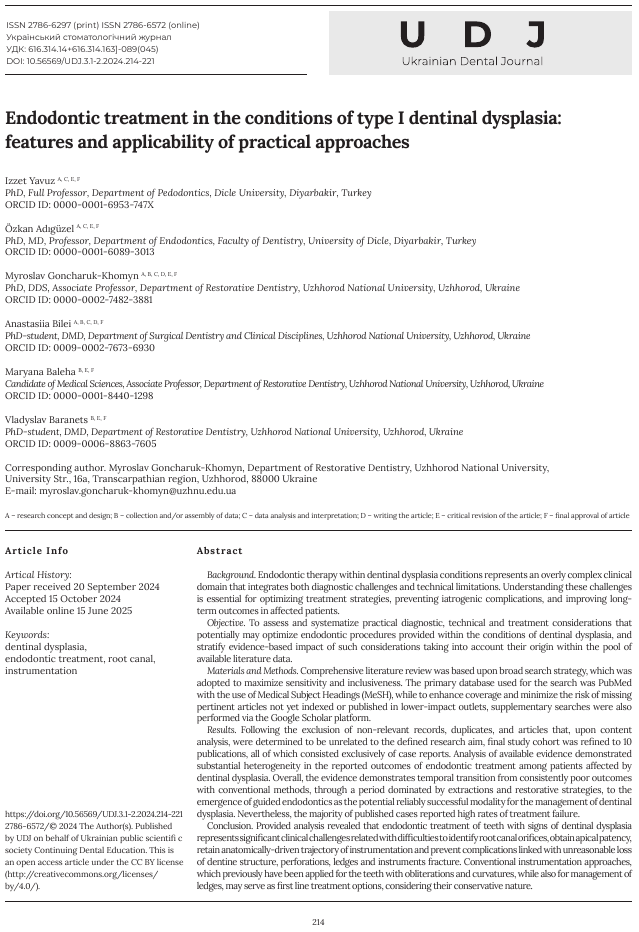Endodontic treatment in the conditions of type I dentinal dysplasia: features and applicability of practical approaches
DOI:
https://doi.org/10.56569/UDJ.3.1-2.2024.214-221Keywords:
dentinal dysplasia, endodontic treatment, root canal, instrumentationAbstract
Background. Endodontic therapy within dentinal dysplasia conditions represents an overly complex clinical domain that integrates both diagnostic challenges and technical limitations. Understanding these challenges is essential for optimizing treatment strategies, preventing iatrogenic complications, and improving long-term outcomes in affected patients.
Objective. To assess and systematize practical diagnostic, technical and treatment considerations that potentially may optimize endodontic procedures provided within the conditions of dentinal dysplasia, and stratify evidence-based impact of such considerations taking into account their origin within the pool of available literature data.
Materials and Methods. Comprehensive literature review was based upon broad search strategy, which was adopted to maximize sensitivity and inclusiveness. The primary database used for the search was PubMed with the use of Medical Subject Headings (MeSH), while to enhance coverage and minimize the risk of missing pertinent articles not yet indexed or published in lower-impact outlets, supplementary searches were also performed via the Google Scholar platform.
Results. Following the exclusion of non-relevant records, duplicates, and articles that, upon content analysis, were determined to be unrelated to the defined research aim, final study cohort was refined to 10 publications, all of which consisted exclusively of case reports. Analysis of available evidence demonstrated substantial heterogeneity in the reported outcomes of endodontic treatment among patients affected by dentinal dysplasia. Overall, the evidence demonstrates temporal transition from consistently poor outcomes with conventional methods, through a period dominated by extractions and restorative strategies, to the emergence of guided endodontics as the potential reliably successful modality for the management of dentinal dysplasia. Nevertheless, the majority of published cases reported high rates of treatment failure.
Conclusion. Provided analysis revealed that endodontic treatment of teeth with signs of dentinal dysplasia represents significant clinical challenges related with difficulties to identify root canal orifices, obtain apical patency, retain anatomically-driven trajectory of instrumentation and prevent complications linked with unreasonable loss of dentine structure, perforations, ledges and instruments fracture. Conventional instrumentation approaches, which previously have been applied for the teeth with obliterations and curvatures, while also for management of ledges, may serve as first line treatment options, considering their conservative nature.
Conflict of Interest
Author does not have any potential conflict of interests that may influence the decision to publish this article.
Funding
No funding was received to assist in preparation and conduction of this research, as well as in composition of this article.
References
1. De Coster PJ. Dentin disorders: anomalies of dentin formation and structure. Endod Topics. 2009 Sep;21(1):41-61. doi: https://doi.org/10.1111/j.1601-1546.2012.00272.x
2. De Coster PJ, Marks LA, Martens LC, Huysseune A. Dental agenesis: genetic and clinical perspectives. J Oral Pathol Med. 2009;38(1):1-7. doi: https://doi.org/10.1111/j.1600-0714.2008.00699.x
3. Krug R, Volland J, Reich S, Soliman S, Connert T, Krastl G. Guided endodontic treatment of multiple teeth with dentin dysplasia: a case report. Head Face Med. 2020;16(1):27. doi: https://doi.org/10.1186/s13005-020-00240-4
4. Seow WK. Developmental defects of enamel and dentine: challenges for basic science research and clinical management. Aust Dent J. 2014;59:143-54. doi: https://doi.org/10.1111/adj.12104
5. Buchanan GD, Tredoux S, Nel C, Gamieldien MY. Endodontic treatment of dentin dysplasia type ID. Aust Endod J. 2021;47(2):343-9. doi: https://doi.org/10.1111/aej.12444
6. Barron MJ, McDonnell ST, MacKie I, Dixon MJ. Hereditary dentine disorders: dentinogenesis imperfecta and dentine dysplasia. Orphanet J Rare Dis. 2008;3(1):31. doi: https://doi.org/10.1186/1750-1172-3-31
7. Ranjitkar S, Yong R, Wu IC, Gully G, Farmer D, Watson I, Heithersay G. Dentinal dysplasia type 1: A 3D micro‐computed tomographic study of enamel, dentine and root canal morphology. Aust Endod J. 2019;45(3):298-304. doi: https://doi.org/10.1111/aej.12359
8. Tidwell E, Cunningham CJ. Dentinal dysplasia: endodontic treatment, with case report. J Endod. 1979;5(12):372-6. doi: https://doi.org/10.1016/s0099-2399(79)80064-3
9. Jafarzadeh H, Azarpazhooh A, Mayhall JT. Taurodontism: a review of the condition and endodontic treatment challenges. Int Endod J. 2008;41(5):375-88. doi: https://doi.org/10.1111/j.1365-2591.2008.01388.x
10. Saberi E, Rezvani S. Endodontic Management of Dentin Dysplasia Type II in a Pediatric Patient: A Case Report. Iran Endod J. 2025;20(1):e17. doi: https://doi.org/10.22037/iej.v20i1.47021
11. Luder HU. Malformations of the tooth root in humans. Front Physiol. 2015;6:307. doi: https://doi.org/10.3389/fphys.2015.00307
12. Rasaratnam L, Djemal S. Type-1 dentine dysplasia–diagnostic and clinical challenges in restorative management. Dent Update. 2017;44(3):174-80. doi: https://doi.org/10.12968/denu.2017.44.3.174
13. Coke JM, Del Rosso G, Remeikis N, Van Cura JE. Dentinal dysplasia, Type I: Report of a case with endodontic therapy. Oral Surg Oral Med Oral Pathol. 1979;48(3):262-8. doi: https://doi.org/10.1016/0030-4220(79)90015-x
14. Steidler NE, Radden BG, Reade PC. Dentinal dysplasia: a clinicopathological study of eight cases and review of the literature. Br J Oral Maxillofac Surg. 1984;22(4):274-86. doi: https://doi.org/10.1016/0266-4356(84)90084-6
15. Rankow H, Miller AS. Dentin dysplasia: endodontic considerations and report of involvement of three siblings. J Endod. 1984;10(8):384-6. doi: https://doi.org/10.1016/S0099-2399(84)80159-4
16. Shankly PE, Mackie IC, Sloan P. Dentinal dysplasia type I: report of a case. Int J Paediatr Dent. 1999;9(1):37-42. doi: https://doi.org/10.1046/j.1365-263x.1999.00106.x
17. Özer L, Karasu H, Aras K, Tokman B, Ersoy E. Dentin dysplasia type I: report of atypical cases in the permanent and mixed dentitions. Oral Surg Oral Med Oral Pathol Oral Radiol Endod. 2004;98(1):85-90. doi: https://doi.org/10.1016/j.tripleo.2004.01.005
18. Ravanshad S, Khayat A. Endodontic therapy on a dentition exhibiting multiple periapical radiolucencies associated with dentinal dysplasia Type 1. Aust Endod J. 2006;32(1):40-2. doi: https://doi.org/10.1111/j.1747-4477.2006.00008.x
19. Alhilou A, Beddis HP, Mighell AJ, Durey K. Dentin dysplasia: diagnostic challenges. BMJ Case Reports. 2018;2018:bcr2017223942. doi: https://doi.org/10.1136/bcr-2017-223942
20. Petersson A. A case of dentinal dysplasia and/or calcification of the dentinal papilla. Oral Surg Oral Med Oral Pathol. 1972;33(6):1014-7. doi: https://doi.org/10.1016/0030-4220(72)90193-4.
21. Connert T, Weiger R, Krastl G. Present status and future directions–Guided endodontics. Int Endod J. 2022;55:995-1002. doi: https://doi.org/10.1111/iej.13687
22. Sabanik P, Samiei M, Avval ST, Cavalcanti B. Guided Endodontics in Managing Root Canal Treatment for Anomalous Teeth—A Narrative Review. Aust Endod J. 2025;online ahead of print. doi: https://doi.org/10.1111/aej.70007
23. McCabe PS, Dummer PM. Pulp canal obliteration: an endodontic diagnosis and treatment challenge. Int Endod J. 2012;45(2):177-97. doi: https://doi.org/10.1111/j.1365-2591.2011.01963.x
24. Chaniotis A, Ordinola‐Zapata R. Present status and future directions: Management of curved and calcified root canals. Int Endod J. 2022;55:656-84. doi: https://doi.org/10.1111/iej.13685
25. American Academy of Pediatric Dentistry. Guideline on dental management of heritable dental developmental anomalies. Pediatr Dent. 2013;36:264–9.
26. Fulari SG, Tambake DP. Rootless teeth: Dentin dysplasia type I. Contemporary clinical dentistry. 2013;4(4):520-2.
27. Goncharuk-Khomyn M, Yavuz I, Cavalcanti AL, Boykiv A, Nahirny Y. Key aspects of dental diagnostics and treatment specifics in ectodermal dysplasia patients: Comprehensive literature review. J Stomat. 2020;73(6):342-50. doi: https://doi.org/10.5114/jos.2020.102053
28. Yavuz Y, Doğan MS, Goncharuk-Khomyn M. Ectodermal Dysplasia: A Review. Makara J Health Res. 2021;25(3):9. doi: https://doi.org/10.7454/msk.v25i3.1305

Downloads
Published
Issue
Section
Categories
License
Copyright (c) 2024 The Author(s)

This work is licensed under a Creative Commons Attribution 4.0 International License.








